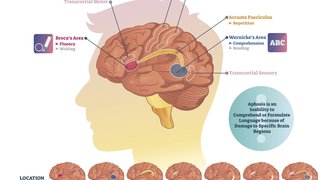
When an older adult falls, it is scary for the person and his or her family. What usually comes to mind are broken bones and bruises that can take longer to heal and often become more serious the older we get.
But of all the medical problems falls can cause in older adults, one of the most serious is traumatic brain injury (TBI). Whether from an accident when riding a bike, taking a tumble from a ladder, making a misstep on an uneven surface, or other reasons, more than 80 percent of TBI in adults age 65 and older is caused by falls.
Older adults are the fastest growing demographic for TBI in the United States. They also are more likely to suffer serious symptoms from head trauma, and they have the highest rates of hospitalization and death related to traumatic brain injury of any age group.
So, why are older adults are at higher risk for falling than young adults and even kids? The answer lies in how our brains and bodies change as we age.
How ‘brain shrinkage’ affects brain injury risk in older adults who fall
Falls are a common occurrence for adults in their 70s and beyond. With aging, our risk for falls increases for many reasons, including vision problems, trouble with the feet (including neuropathy), and side effects of medication.
As we age, our bodies start to shrink. The same goes for our brains. As the brain shrinks, more space is left between the brain and the skull. That doesn’t mean we become less intelligent or that we have dementia – it’s simply a natural physical process.
The blood vessels that connect the brain to the skull – called bridging veins – also shrink and become tighter, thinner, and more susceptible to damage.
After a fall or other accident, the bridging veins can develop a slow blood leak called a subdural hematoma – a bruise in the brain that doesn’t stop bleeding the way a typical bruise does. If the patient is taking blood thinners, aspirin, or other anti-inflammatory medications, the blood leak could become more severe.
TBI symptoms in older adults
Aside from classic concussion symptoms such as headache, nausea, and sensitivity to light, there are additional cognitive and physical TBI symptoms to watch for in older adults:
- Confusion
- Memory loss
- Problems with balance
- Bladder incontinence
The appearance of these symptoms is one of the key indicators of brain damage. If these symptoms suddenly arise in an individual who seemed fine a week or two before, the symptoms could indicate TBI from a fall, vehicle accident, or other incident, and not from the natural aging process.
Many older adults have some small degree of memory loss, and they do just fine day to day. But if they are involved in an accident, their memory loss can become more problematic. In some cases, the patient and his or her loved ones find out about existing memory loss that had gone unnoticed or that the person was coping with well.
Traumatic brain injury treatment for older adults
If an older adult suffers a concussion, the treatment is similar to a younger adult’s treatment: cognitive and physical rest with a gradual return to normal activities. Though the recovery process is similar, it often takes older adults longer to recover. As we age, the body heals more slowly from injuries.
Brain bleeding can be a concern because it can expand and result in, for instance, loss of consciousness, another fall, or permanent memory problems. If a brain bleed occurs, we keep a close eye on it with CT scanning. If the bleeding doesn’t get worse, we’ll continue to monitor it like any other bruise – eventually the blood will break down and be reabsorbed by the body.
If the bleeding does get worse, we may need to drain the hematoma and relieve pressure in the brain to avoid long-term brain damage or even death. In severe cases, we perform full neurosurgery to remove a portion of the skull and decrease pressure in the brain. For mild cases, we sometimes can drill a hole in the skull, called a Burr hole, and avoid full surgery.
I want my patients and their caregivers to know that concussions, subdural hematomas, and other mild brain injuries often are treatable if the patient gets help as soon as possible after the injury. Older patients often are afraid to visit the doctor for fear of losing their independence or causing loved ones to worry. However, it’s much safer and much less of a worry for people to get the care they need than to develop permanent problems with memory or balance. A trip to the emergency room is preferable to dealing with potentially treatable symptoms that decrease quality of life!
5 tips to avoid falls at home
Though you can’t fall-proof your surroundings everywhere you go, there are things you can do at home to prevent yourself or loved ones from falling, including:
- Be aware of the side effects of your medication. Some medications have obvious side effects, such as blood thinners, which can increase bruising and bleeding. Others may come with less obvious side effects, such as dizziness or vision problems.
- Work on balance and movement. As we age, many of us become more sedentary. But it’s very important for older adults to stay active and work on balance in order to remain strong and thus safer at home.
- Create safe surfaces. Throw rugs are notorious for tripping people, so consider getting rid of them or use slip-proof backing. Place non-slip stickers on the bathtub floor to help prevent falls during bathing.
- Wear appropriate footwear. House shoes that slip on the feet may be comfortable, but they can easily come off your feet and trip you. Individuals who suffer from neuropathy of the feet should always wear appropriate shoes to avoid foot injuries, and most of these are well-designed to stay on the feet.
- Light up walkways. Make sure stairs are well-lit, and consider using lamps or nightlights to increase safety for those who get up in the night.
As we and our loved ones age, it becomes increasingly important to be proactive with safety and health care. When accidents do happen, don’t wait to get help. Symptoms that may seem vague or unimportant can quickly develop into situations that seriously affect your health.










